Yoga has been a thing for a long time now. But have you ever heard of a yoga app?
Well, with digitalization of almost every industry, it was only a matter of time before we would see people investing in yoga app development. And to their credit, it is a good move.
There are millions or even billions of people across the world who engages in the ancient practice of yoga to balance their mind and soul.
And won’t you know it, in blink of an eye, these yoga apps had explosive growth, generating traffic in billions.
Well, in this blog, we shall be discussing all you need to know about yoga app development from inspiration to development and cost.
Therefore, let’s get right into it:
Understanding Yoga Apps
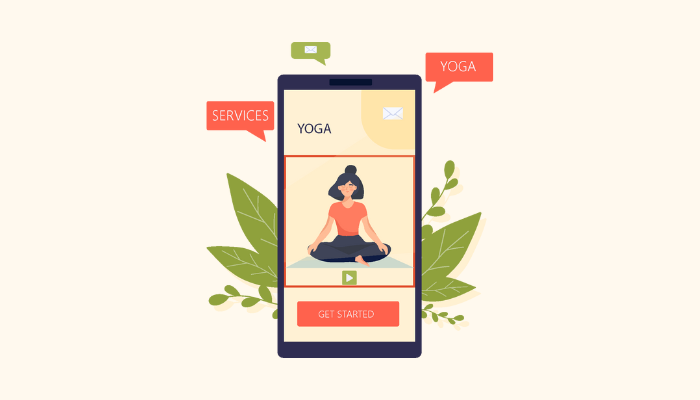
So, what the heck are yoga apps?
A good example of custom health app development, yoga apps are a purpose built solution. What they do is, they enables yoga related businesses to deliver service to their end-user digitally.
Now, the term “service” here can vary based on the type of yoga app or the business using the app.
For instance you can make a yoga instruction app or a yoga based meditation app like calm. In any case, that’s what the goal of yoga app development is.
And if you are planning to develop such a solution, it’s good idea to learn from the best in market.
Popular Yoga Apps For Inspiration
Planning to develop a yoga app? well, you should learn from the best yoga apps in market. So, these are, as mentioned below:
Down Dog
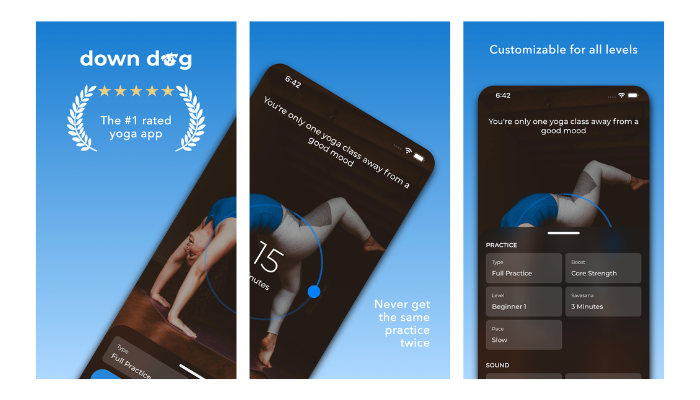
With this down dog app, you can customize your yoga sessions based on your skill level, time constraints, and even the kind of music you prefer.
It offers a wide variety of yoga styles and sequences to keep your practice fresh and exciting.
Yoga Studio
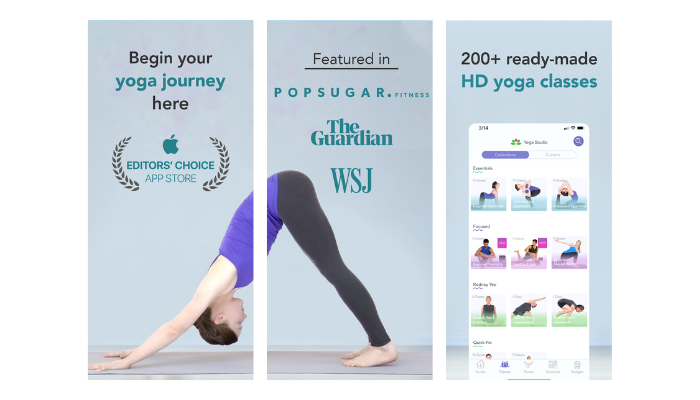
This Yoga Studio app is known for its high-quality video content and well-structured classes.
Whether you’re a beginner or an experienced yogi, you’ll find classes that suit your needs and help you progress in your practice.
Daily Yoga
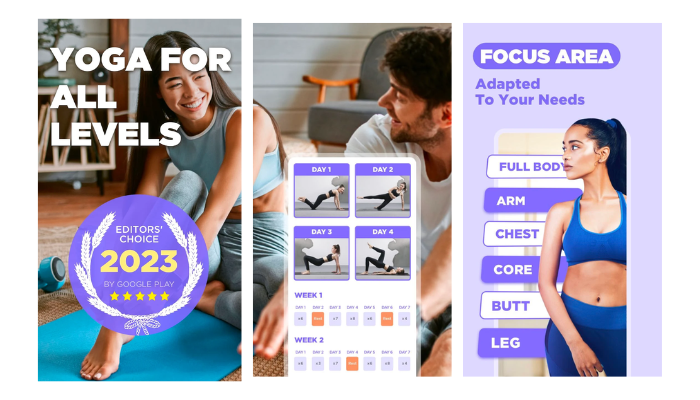
Perfect for those with busy schedules, Daily Yoga offers short and effective sessions that can be easily integrated into your daily routine.
It also provides specialized programs for different goals like weight loss, flexibility, and relaxation.
Asana Rebel
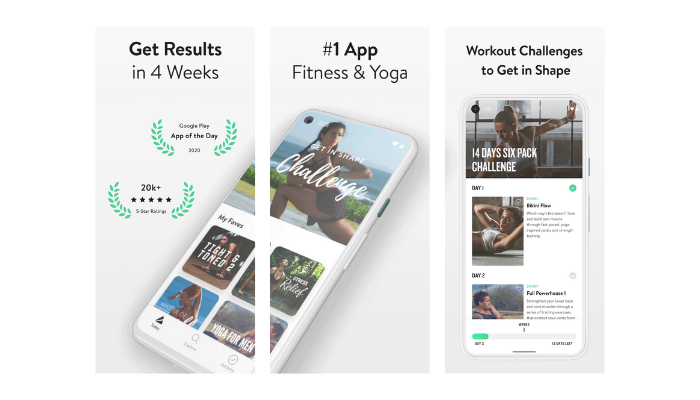
If you want a combination of yoga and fitness, Asana Rebel might be the app for you.
It blends yoga-inspired workouts with bodyweight exercises to improve strength, flexibility, and mindfulness.
Glo (formerly YogaGlo)
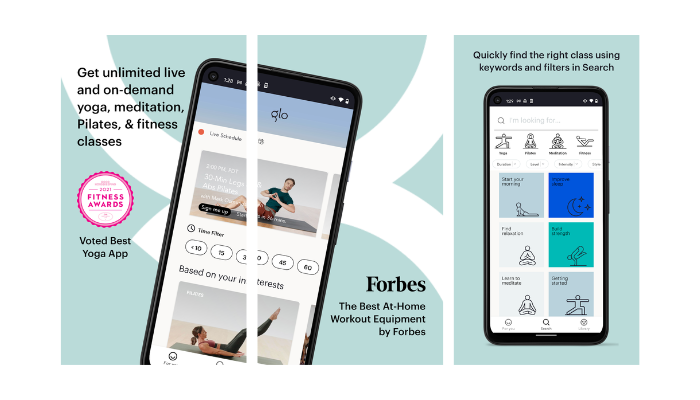
The Glo app features classes from world-renowned yoga teachers, providing you with a wide range of styles and expertise. You can choose classes based on your interests and level of experience.
Simply Yoga
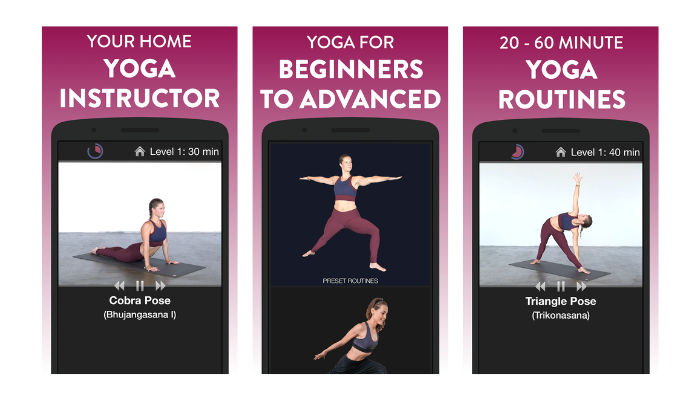
A user-friendly app that’s great for beginners, Simply Yoga offers easy-to-follow video sessions that focus on the fundamentals of yoga poses and relaxation techniques.
Pocket Yoga
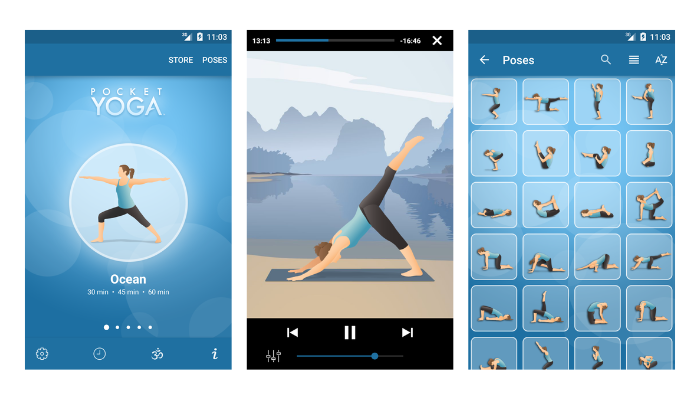
If you prefer practicing offline, Pocket Yoga is an excellent choice.
It provides detailed voice and visual guidance, making it feel like you have your own personal yoga instructor with you.
Now that you have inspiration for yoga app development, let’s look at from a Business and investor’s POV.
Should You Invest in Yoga App Development?
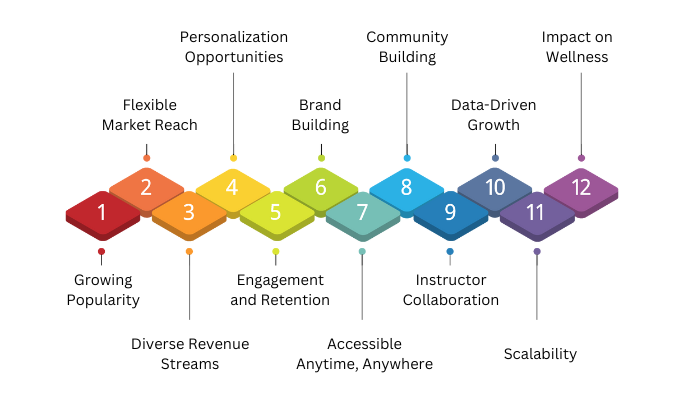
Investing in app development can be a big decision.
And to decide whether or not to invest in it, there are a lot of consideration to make. But here, we shall be giving some good reasons to go for yoga app development.
Therefore, with this being said, let’s get right into it:
· Growing Popularity
Yoga’s popularity is on the rise, with more people embracing its physical and mental benefits. Developing a yoga app allows you to tap into this growing market and cater to a broad audience.
· Flexible Market Reach
An app enables you to reach users globally, breaking geographical barriers and expanding your potential customer base beyond a specific location.
· Diverse Revenue Streams
Yoga apps offer various monetization options, such as one-time purchases, subscription models, or in-app purchases. These diverse revenue streams can create a stable income source for your business.
· Personalization Opportunities
You can create a customized experience for users by offering personalized yoga plans, progress tracking, and tailored content based on their goals and preferences.
· Engagement and Retention
Apps can provide interactive features like progress tracking, reminders, and challenges that boost user engagement and encourage long-term usage of the app.
· Brand Building
Developing a well-designed and user-friendly app can enhance your brand’s reputation and credibility within the yoga community, attracting more users and potential partnerships.
· Accessible Anytime, Anywhere
Users can practice yoga whenever and wherever they want with your app, making it convenient for those with busy schedules or limited access to yoga studios.
· Community Building:
integrate social features in your app to foster a sense of community among users, allowing them to share experiences, encourage each other, and build a supportive network.
· Instructor Collaboration
Partnering with experienced yoga instructors can add value to your app and attract users seeking guidance from reputable teachers.
· Data-Driven Growth
With app analytics, you can gain insights into user behavior, preferences, and trends, helping you make data-driven decisions to improve the app and cater to users’ evolving needs.
· Scalability
Once your app gains traction, it has the potential to scale rapidly without significant physical infrastructure, leading to increased profitability over time.
· Impact on Wellness
By providing accessible yoga resources, your app can positively impact people’s well-being, fostering a sense of accomplishment as users progress in their practice.
Who Should Develop A Yoga App?
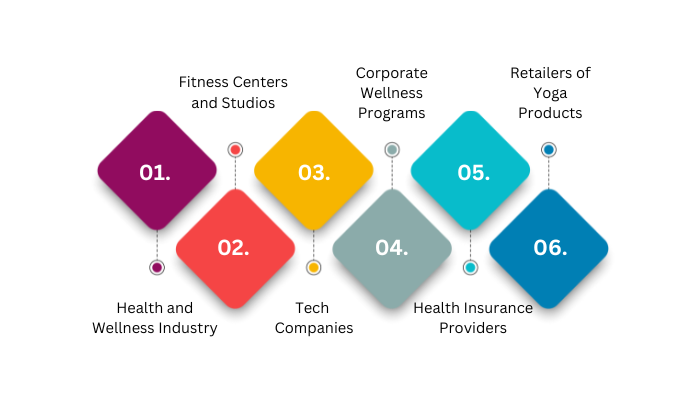
So, who should hire app developers and develop a yoga app?
Well, there are a lot of businesses who can benefit from this. And in this blog, we shall be discussing the same.
Therefore, with this being said, let’s get right into it:
· Health and Wellness Industry
If your business operates within the health and wellness sector, investing in a yoga app aligns perfectly with your target audience.
It allows you to offer a valuable tool that promotes physical and mental well-being, which can strengthen your brand’s image and customer loyalty.
· Fitness Centers and Studios
For fitness centers and yoga studios, a dedicated yoga app can enhance the overall customer experience.
It enables you to extend your services beyond the physical location and offer virtual classes, tutorials, and personalized practice sessions.
This fosters a sense of community among your clients and attracts new ones.
· Tech Companies
If your business is in the technology industry, venturing into yoga app development diversifies your product portfolio.
Yoga apps often incorporate innovative features like AI-based personalized recommendations, real-time feedback, and virtual reality experiences, which can showcase your technical expertise.
· Corporate Wellness Programs
Companies that provide corporate wellness solutions can benefit from investing in a yoga app.
Offering a digital platform for yoga and meditation can contribute to reducing employee stress, improving productivity, and fostering a healthier work environment.
· Health Insurance Providers
As a health insurance company, creating or partnering with a yoga app can be a strategic move.
Encouraging your policyholders to practice yoga regularly can lead to better health outcomes, potentially reducing healthcare costs in the long run.
· Retailers of Yoga Products
If you sell yoga-related products, developing a yoga app can complement your business.
The app can feature product catalogs, instructional videos on using your products, and even provide a marketplace for users to purchase yoga equipment and accessories.
Tech Stack For Yoga App Development
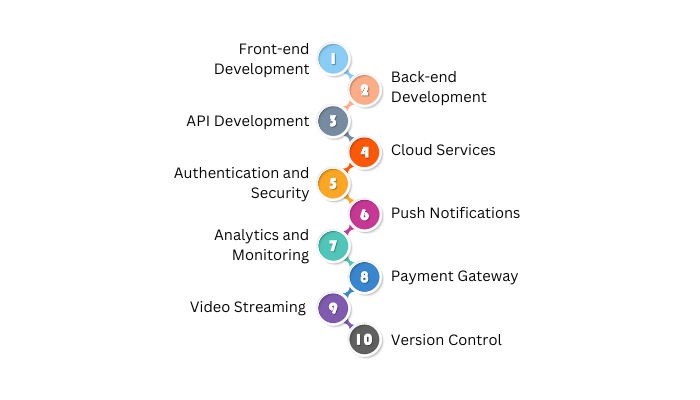
In Yoga App Development, the choice of the tech stack will significantly influence the app’s performance, scalability, and overall development process.
Here’s a recommended tech stack for building a robust yoga app:
Front-end Development:
- Programming Languages: JavaScript, TypeScript (optional)
- UI Framework/Library: React Native or Flutter (for cross-platform development) OR Swift (for iOS) and Kotlin (for Android) for native development
- Styling: CSS (or CSS-in-JS) for web-based apps, or native styling for mobile apps
Back-end Development:
- Programming Languages: Node.js (JavaScript) or Python (Django) or Ruby (Ruby on Rails) or Java (Spring Boot)
- Web Framework: Express.js (for Node.js) or Django (for Python) or Ruby on Rails (for Ruby) or Spring Boot (for Java)
- Database: PostgreSQL or MySQL for relational databases, or MongoDB for NoSQL (depending on the app’s requirements)
API Development:
- RESTful API: For communication between the front-end and back-end, you can use RESTful APIs to handle data exchange.
Cloud Services:
- Hosting: Amazon Web Services (AWS), Microsoft Azure, or Google Cloud Platform (GCP) for hosting the app and databases.
- Cloud Storage: AWS S3 or Google Cloud Storage for storing media files like images and videos.
Authentication and Security:
- Authentication: JSON Web Tokens (JWT) or OAuth 2.0 for user authentication and authorization.
- Secure Communication: Implement HTTPS to ensure secure communication between the app and server.
Push Notifications:
- Push Notification Service: Services like Firebase Cloud Messaging (FCM) or Apple Push Notification Service (APNs) for sending push notifications to users.
Analytics and Monitoring:
- Analytics: Integrate tools like Google Analytics or Mixpanel to track user behavior and app usage.
- Error Monitoring: Services like Sentry or Crashlytics for monitoring and tracking app errors.
Payment Gateway:
- Payment Integration: To facilitate in-app purchases or subscription payments, integrate a reliable payment gateway like Stripe or PayPal.
Video Streaming (if providing live classes or video content):
- Video Hosting: Services like Vimeo or Wistia for hosting and streaming video content.
- Video Streaming Protocol: Use HLS (HTTP Live Streaming) for adaptive video streaming.
Version Control:
- Git: Use Git for version control to manage codebase changes efficiently.
Yoga App Development Process
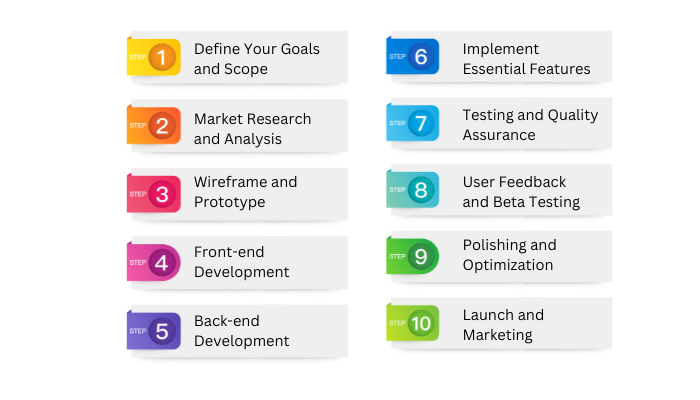
Do you have an amazing idea that you want to convert to reality? Well, here’s the entire yoga app development process to do just that.
1. Define Your Goals and Scope
Begin by clearly defining the goals of your yoga app. Determine the specific features you want to include and the scope of the project.
Consider your target audience, app platforms (iOS, Android, web), and the overall purpose of the app.
2. Market Research and Analysis
Conduct comprehensive market research to understand the existing yoga apps, their strengths, weaknesses, and user preferences.
Identify your competitors and analyze user feedback to discover opportunities for innovation.
3. Create a Detailed Wireframe and Prototype
Design a detailed wireframe that outlines the app’s layout, user interface, and navigation flow.
This step will help you visualize the user experience before moving into development.
Create a prototype to demonstrate how users will interact with the app.
4. Front-end Development
Start building the front-end of the app, focusing on creating an intuitive and visually appealing user interface.
Implement the wireframe design, ensuring responsiveness across different devices and screen sizes.
5. Back-end Development
Develop the back-end of the app, including the server, database, and APIs.
Handle user authentication, data storage, and business logic. Ensure the back-end supports the functionalities required for the app’s features.
6. Implement Essential Features
Integrate essential features such as:
- User-Friendly Interface
- Yoga Pose Library
- Customizable Yoga Programs
- Video Tutorials and Classes
- Progress Tracking
- Reminders and Scheduling
- Meditation and Breathing Exercises
- Offline Access
- Community and Social Sharing
- Integration with Wearable Devices
Test each feature to ensure they function seamlessly.
7. Testing and Quality Assurance
Conduct thorough testing at various stages of yoga app development.
Perform both manual and automated testing to identify and fix bugs, glitches, or usability issues. Ensure the app is stable and meets quality standards.
8. User Feedback and Beta Testing
Gather feedback from a group of beta testers to gain insights into user satisfaction and identify any areas that need improvement.
Analyze their feedback and make necessary refinements.
9. Polishing and Optimization
Based on user feedback and testing results, polish the app and optimize it for performance and speed. Address any issues, refine the user interface, and enhance the overall user experience.
10. Launch and Marketing
Once you are confident in the app’s stability and functionality, launch it on the respective app stores (Apple App Store and Google Play Store) or as a web application.
Plan a marketing strategy to promote your yoga app, utilizing social media, content marketing, and partnerships to reach your target audience effectively.
Bottom Line
This is how you convert an idea to working app via yoga app development. And with this said, we have come to the end of our blog.
Now, if you want to do just that, it’s highly recommended that you consult a top app development firm.
FAQ
A yoga app is a mobile application that offers yoga-related content, tutorials, poses, and guided sessions to help users practice yoga anytime, anywhere.
Yoga apps provide convenient access to yoga routines, promote mindfulness, enhance flexibility, and encourage overall well-being.
Essential features include pose libraries, guided sessions, user profiles, progress tracking, customizable routines, and meditation support.
Content is curated by certified yoga instructors, including a variety of poses, difficulty levels, and thematic sessions to cater to diverse user needs.
Ideally, a yoga app should be available for both iOS and Android devices to reach a broader audience.
Gamification, achievement badges, challenges, and personalized recommendations can keep users engaged and motivated in their yoga journey.
Implement secure login methods, encrypt user data, and have a transparent privacy policy to safeguard user information.
Leverage social media, collaborate with influencers, offer free trials, and use targeted ads to reach potential users interested in health and wellness.
Monetization options include subscription models, in-app purchases for premium content, advertisements, or a combination of these methods.
Opt for a reliable tech stack, such as React Native, Flutter, or native development, to ensure a smooth and efficient app performance.
Regularly update the app with bug fixes and new features based on user feedback to enhance the overall user experience.
Yes, obtain necessary licenses for using copyrighted content, comply with data protection regulations, and have clear terms of service.
Focus on a user-friendly interface, unique content, exceptional user support, and a seamless experience to differentiate your app from others.
Social features like sharing progress, challenges, and achievements can foster a sense of community among users and enhance engagement.
Design the app with scalable architecture, use cloud-based solutions, and continuously monitor performance to handle increasing user demands.

Niketan Sharma is the CTO of Nimble AppGenie, a prominent website and mobile app development company in the USA that is delivering excellence with a commitment to boosting business growth & maximizing customer satisfaction. He is a highly motivated individual who helps SMEs and startups grow in this dynamic market with the latest technology and innovation.
Table of Contents












No Comments
Comments are closed.